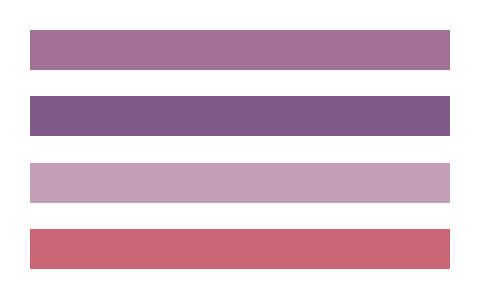color
A color in a specific color space.
Typst supports:
- sRGB through the
rgbfunction - Device CMYK through
cmykfunction - D65 Gray through the
lumafunction - Oklab through the
oklabfunction - Oklch through the
oklchfunction - Linear RGB through the
color.linear-rgbfunction - HSL through the
color.hslfunction - HSV through the
color.hsvfunction
Example
#rect(fill: aqua)

Predefined colors
Typst defines the following built-in colors:
| Color | Definition |
|---|---|
black | luma(0) |
gray | luma(170) |
silver | luma(221) |
white | luma(255) |
navy | rgb("#001f3f") |
blue | rgb("#0074d9") |
aqua | rgb("#7fdbff") |
teal | rgb("#39cccc") |
eastern | rgb("#239dad") |
purple | rgb("#b10dc9") |
fuchsia | rgb("#f012be") |
maroon | rgb("#85144b") |
red | rgb("#ff4136") |
orange | rgb("#ff851b") |
yellow | rgb("#ffdc00") |
olive | rgb("#3d9970") |
green | rgb("#2ecc40") |
lime | rgb("#01ff70") |
The predefined colors and the most important color constructors are
available globally and also in the color type's scope, so you can write
either color.red or just red.
Predefined color maps
Typst also includes a number of preset color maps that can be used for gradients. Most of these color maps are chosen to be color blind friendly.
| Map | Details |
|---|---|
turbo | A perceptually uniform rainbow-like color map. Read this blog post for more details. |
cividis | A blue to gray to yellow color map. See this blog post for more details. |
rainbow | Cycles through the full color spectrum. This color map is best used by setting the interpolation color space to HSL. The rainbow gradient is not suitable for data visualization because it is not perceptually uniform, so the differences between values become unclear to your readers. It should only be used for decorative purposes. |
spectral | Red to yellow to blue color map. |
viridis | A purple to teal to yellow color map. |
inferno | A black to red to yellow color map. |
magma | A black to purple to yellow color map. |
plasma | A purple to pink to yellow color map. |
rocket | A black to red to white color map. |
mako | A black to teal to yellow color map. |
vlag | A light blue to white to red color map. |
icefire | A light teal to black to yellow color map. |
flare | A orange to purple color map that is perceptually uniform. |
crest | A blue to white to red color map. |
Some popular presets are not included because they are not available under a free licence. Others, like Jet, are not included because they are not color blind friendly. Feel free to use or create a package with other presets that are useful to you!
定义
函数和类型可以有与其关联的定义 (成员或方法)。可以使用 "." 操作符来访问调用它们。
luma
Create a grayscale color.
A grayscale color is represented internally by a single lightness
component.
These components are also available using the
components method.
 查看示例
查看示例
#for x in range(250, step: 50) {
box(square(fill: luma(x)))
}

lightness
The lightness component.
color
Alternatively: The color to convert to grayscale.
If this is given, the lightness should not be given.
oklab
Create an Oklab color.
This color space is well suited for the following use cases:
- Color manipulation such as saturating while keeping perceived hue
- Creating grayscale images with uniform perceived lightness
- Creating smooth and uniform color transition and gradients
A linear Oklab color is represented internally by an array of four components:
- lightness (
ratio) - a (
floatorratio. Ratios are relative to0.4; meaning50%is equal to0.2) - b (
floatorratio. Ratios are relative to0.4; meaning50%is equal to0.2) - alpha (
ratio)
These components are also available using the
components method.
 查看示例
查看示例
#square(
fill: oklab(27%, 20%, -3%, 50%)
)

lightness
The lightness component.
a
The a ("green/red") component.
b
The b ("blue/yellow") component.
alpha
The alpha component.
color
Alternatively: The color to convert to Oklab.
If this is given, the individual components should not be given.
oklch
Create an Oklch color.
This color space is well suited for the following use cases:
- Color manipulation involving lightness, chroma, and hue
- Creating grayscale images with uniform perceived lightness
- Creating smooth and uniform color transition and gradients
A linear Oklch color is represented internally by an array of four components:
- lightness (
ratio) - chroma (
floatorratio. Ratios are relative to0.4; meaning50%is equal to0.2) - hue (
angle) - alpha (
ratio)
These components are also available using the
components method.
 查看示例
查看示例
#square(
fill: oklch(40%, 0.2, 160deg, 50%)
)

lightness
The lightness component.
chroma
The chroma component.
hue
The hue component.
alpha
The alpha component.
color
Alternatively: The color to convert to Oklch.
If this is given, the individual components should not be given.
linear-rgb
Create an RGB(A) color with linear luma.
This color space is similar to sRGB, but with the distinction that the
color component are not gamma corrected. This makes it easier to perform
color operations such as blending and interpolation. Although, you
should prefer to use the oklab function for these.
A linear RGB(A) color is represented internally by an array of four components:
These components are also available using the
components method.
 查看示例
查看示例
#square(fill: color.linear-rgb(
30%, 50%, 10%,
))

red
The red component.
green
The green component.
blue
The blue component.
alpha
The alpha component.
color
Alternatively: The color to convert to linear RGB(A).
If this is given, the individual components should not be given.
rgb
Create an RGB(A) color.
The color is specified in the sRGB color space.
An RGB(A) color is represented internally by an array of four components:
These components are also available using the components
method.
 查看示例
查看示例
#square(fill: rgb("#b1f2eb"))
#square(fill: rgb(87, 127, 230))
#square(fill: rgb(25%, 13%, 65%))

red
The red component.
green
The green component.
blue
The blue component.
alpha
The alpha component.
hex
Alternatively: The color in hexadecimal notation.
Accepts three, four, six or eight hexadecimal digits and optionally a leading hash.
If this is given, the individual components should not be given.
 查看示例
查看示例
#text(16pt, rgb("#239dad"))[
*Typst*
]

color
Alternatively: The color to convert to RGB(a).
If this is given, the individual components should not be given.
cmyk
Create a CMYK color.
This is useful if you want to target a specific printer. The conversion to RGB for display preview might differ from how your printer reproduces the color.
An HSL color is represented internally by an array of four components:
These components are also available using the
components method.
 查看示例
查看示例
#square(
fill: cmyk(27%, 0%, 3%, 5%)
)

cyan
The cyan component.
magenta
The magenta component.
yellow
The yellow component.
key
The key component.
color
Alternatively: The color to convert to CMYK.
If this is given, the individual components should not be given.
hsl
Create an HSL color.
This color space is useful for specifying colors by hue, saturation and lightness. It is also useful for color manipulation, such as saturating while keeping perceived hue.
An HSL color is represented internally by an array of four components:
These components are also available using the
components method.
 查看示例
查看示例
#square(
fill: color.hsl(30deg, 50%, 60%)
)

hue
The hue angle.
saturation
The saturation component.
lightness
The lightness component.
alpha
The alpha component.
color
Alternatively: The color to convert to HSL.
If this is given, the individual components should not be given.
hsv
Create an HSV color.
This color space is useful for specifying colors by hue, saturation and value. It is also useful for color manipulation, such as saturating while keeping perceived hue.
An HSV color is represented internally by an array of four components:
These components are also available using the
components method.
 查看示例
查看示例
#square(
fill: color.hsv(30deg, 50%, 60%)
)

hue
The hue angle.
saturation
The saturation component.
value
The value component.
alpha
The alpha component.
color
Alternatively: The color to convert to HSL.
If this is given, the individual components should not be given.
components
Extracts the components of this color.
The size and values of this array depends on the color space. You can
obtain the color space using space. Below is a table
of the color spaces and their components:
| Color space | C1 | C2 | C3 | C4 |
|---|---|---|---|---|
luma | Lightness | |||
oklab | Lightness | a | b | Alpha |
oklch | Lightness | Chroma | Hue | Alpha |
linear-rgb | Red | Green | Blue | Alpha |
rgb | Red | Green | Blue | Alpha |
cmyk | Cyan | Magenta | Yellow | Key |
hsl | Hue | Saturation | Lightness | Alpha |
hsv | Hue | Saturation | Value | Alpha |
For the meaning and type of each individual value, see the documentation
of the corresponding color space. The alpha component is optional and
only included if the alpha argument is true. The length of the
returned array depends on the number of components and whether the alpha
component is included.
 查看示例
查看示例
// note that the alpha component is included by default
#(rgb(40%, 60%, 80%).components() == (40%, 60%, 80%, 100%))

alpha
Whether to include the alpha component.
默认:true
space
Returns the constructor function for this color's space:
 查看示例
查看示例
#let color = cmyk(1%, 2%, 3%, 4%)
#(color.space() == cmyk)

to-hex
Returns the color's RGB(A) hex representation (such as #ffaa32 or
#020304fe). The alpha component (last two digits in #020304fe) is
omitted if it is equal to ff (255 / 100%).
lighten
Lightens a color by a given factor.
factor
The factor to lighten the color by.
darken
Darkens a color by a given factor.
factor
The factor to darken the color by.
saturate
Increases the saturation of a color by a given factor.
factor
The factor to saturate the color by.
desaturate
Decreases the saturation of a color by a given factor.
factor
The factor to desaturate the color by.
negate
Produces the negative of the color.
rotate
Rotates the hue of the color by a given angle.
angle
The angle to rotate the hue by.
space
The color space used to rotate. By default, this happens in a perceptual
color space (oklch).
默认:oklch
mix
Create a color by mixing two or more colors.
 查看示例
查看示例
#set block(height: 20pt, width: 100%)
#block(fill: red.mix(blue))
#block(fill: red.mix(blue, space: rgb))
#block(fill: color.mix(red, blue, white))
#block(fill: color.mix((red, 70%), (blue, 30%)))

colors
The colors, optionally with weights, specified as a pair (array of length two) of color and weight (float or ratio).
The weights do not need to add to 100%, they are relative to the
sum of all weights.
space
The color space to mix in. By default, this happens in a perceptual
color space (oklab).
默认:oklab